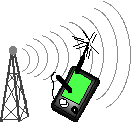
 |
JPL's Wireless Communication Reference WebsiteChapter: Network Concepts and Standards
|

 High radio link performance, spectrum efficient
network design and low terminal power consumption are the main design criteria. To reduce the power
consumption in the terminal, almost all computational tasks are to be performed in the backbone network,
either at the base station or remotely, making the terminal mainly an Input/Output device. The wireless terminal is in full-duplex communication with a networked base
station, which serves as a gateway between the wired and wireless network.
High radio link performance, spectrum efficient
network design and low terminal power consumption are the main design criteria. To reduce the power
consumption in the terminal, almost all computational tasks are to be performed in the backbone network,
either at the base station or remotely, making the terminal mainly an Input/Output device. The wireless terminal is in full-duplex communication with a networked base
station, which serves as a gateway between the wired and wireless network.
In this approach, almost no error-critical data is sent over the wireless link. The radio link to the terminal needs to support dynamic screen data at high rate. This requires a downlink (base station to terminal) with relatively high bandwidth, which may however tolerate occasional signal outages during periods of excessive channel load by other users. The tolerance of signal outages substantially reduces the transmission overhead that would be required other- wise to achieve almost error free exchange of data.
The situation in the uplink is quite different: Many existing notebook computers use a key pad for entering data into the system, but simplified entry mechanisms such as voice recognition and hand-writing recognition are likely to be available in the near future. In order to minimize terminal power consumption, speech recognition will be performed in the base station rather than in the terminal itself. Speech compression techniques have been refined and are available for instance for GSM digital telephony. Such schemes are likely to allow power efficient implementation in the near future. These schemes imply that the uplink (terminals-to-base station) only needs to support relatively low bit rates, say up to 10 kbit per second in a burst mode.

To compute such downlink BER performance, one must realize that in an indoor propagation environment a strong dominant line-of-sight is present plus a tail of delayed reflections. The performance will be much better than that predicted from models assuming that all resolvable paths are i.i.d., thus with identical expected power. We limited our analysis on downlink transmission, i.e., from base station to portable terminals. In this case, all signals arriving at a particular receiver are affected by the same dispersive channel transfer function. The performance of the CDMA transmission method appears to be significantly better for downlink transmission than for (CDMA) uplink transmission, where signals arrive over different channels and with random code synchronization offsets, which erodes the orthogonality of the arriving signals.
Because of the asymmetric requirements Infopad uses a hybrid radio link standard. Direct Sequence (DS-) CDMA is used for downlink transmission, allowing occasional outages of the received (video or audio) signals in the downlink. This is in contrast to the uplink where pen input data, voice commands or key strokes are being transmitted. As these messages arrive according to a very bursty pattern and require very high reliability, Infopad opted for burst-type transmission, with retransmission of packets lost in collisions.
It is well known that DS-CDMA performs best if all signals are received with identical power and if all codes are synchronized. These requirements are easy to accomplish in the downlink: at each receiver all signals are received after seeing the same radio channel. Code synchronization does not pose a problem if all signals originate from the same base station. In the uplink, analyses reveal that band spreading appears less favorable.